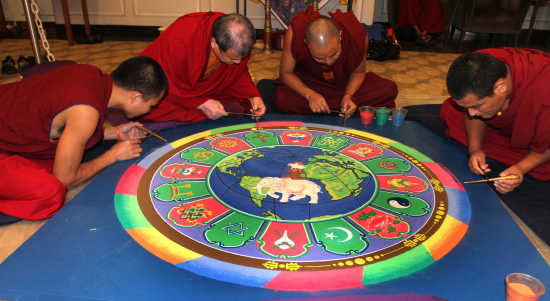Tashi Kyil Monks visit DePauw for world peace mission

For the past several days, Tashi Kyil Monks from the Tashi Kyil Monastery in Dehra-dun, India, visited DePauw University to construct and showcase a sand mandala symbolizing world peace.
Seven monks representing the monastery descended upon DePauw's Union Building after being commissioned to create a mandala, which is a Tibetan sand painting -- an ancient art form of Tibetan Buddhism.
"This is a part of a national tour and they still have a few more locations to go," Lisa Morrison, spokeswoman of the Tibetan Mongolian Buddhist Cultural Center in Bloomington, said.
"It's a traditional art form, but it's not a common one. They're frequently commissioned to create mandalas. Each one has different symbols sometimes, it's peace, compassion or a medicine Buddha, which is for wellness and well life."
The mandala at DePauw has taken the past five days to create and is carefully constructed from dyed sand particles, which the monks brought from India.
The sand is put into place by a narrow metal funnel called a chakpur, which is scraped by another metal rod to cause vibration for the sand to trickle out of its end. This process is said to symbolize the union of wisdom and compassion.
"The one we created here is a world peace mandala," Yeshi Rabgyal said. "It's a message of how to create peace in this world. There are many religious symbols included because we respect each other."
Also included in the mandala is what the monks call the four harmony brothers or mthun pa spun bzhi, which are an elephant, monkey, hare and a bird.
This old Buddhist legend of the four harmony brothers tells a story in which all "brothers" lived together in harmony, helping each other to enjoy the fruits of a tree.
"Ultimately, when we respect each other and we share the love and compassion then ultimately we create peace in this world," Rabgyal said.
Following the completion of the mandala, the monks will then destroy it through a ceremony Saturday beginning at the Union Building at 4 p.m. All are welcome to attend.
"Then we destroy our mandala," Rabgyal explained. "You can see this mandala is so beautiful and so colorful. It's representative because in this world there are many kinds of beautiful things, but at one time they have to go."
This spiritual practice is done by sweeping up the sand and pouring it into a nearby river or stream, a place where the waters carry the healing energies throughout the world.
In the case ofthe DePauw projects, it will conclude at the Prindle Institute.
"It's a custom but it's also a spiritual practice," Morrison said. "It's destroyed at the end of the project and then offered ceremonially into a body of water representing impermanence. Projects like this are an excellent way to teach today's society about this ancient culture, its art form and its practices. These tours are a form of outreach and education and they're absolutely crucial to the preservation of the society."
Along with creating the mandala, the Tashi Kyil monks also sell a variety of items such as jewelry and shawls. Ten percent of all proceeds go directly to support more than 120 refugee monks.
"We buy from the Indian poor people as well as the Tibetian and Fuji people," Rabgyal said. "All of this goes to benefit the monastery, education, medical needs, food and new library constructions."
The Tashi Kyil Monks have been touring America since May and will soon go back to Dehradun in November.
They have been to such places as the Tibet House in New York City and Washington, D.C., as well as Franklin College and Indiana University, all with the goal of preserving the Tibetan culture by sharing what they learn at their monastery, love, peace and compassion as well as fundraising.
The monks will soon travel back to Bloomington for two days of rest at the Tibetan Mongolian Buddhist Cultural Center and then travel to New Albany.
